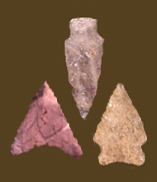
PROJECTILE POINT TYPOLOGY Archaeologists have long recognized that Native Americans made projectile points in different sizes and shapes, and that their appearance changed over time. To sort out the variety of projectile point types, archaeologists name them and assign them to particular cultures or periods of time. For example, the Clovis point is named for an ancient site found near Clovis, New Mexico in the 1920s. Most of the projectile point types found in Maryland were first defined by a handful of archaeologists working in the eastern U.S. during the middle part of the 20th century. Among the leaders were W. Fred Kinsey (in Pennsylvania); William A. Ritchie (New York); Robert L. Stephenson (Maryland); Bettye J. Broyles (West Virginia); and Joffre L. Coe (North Carolina). Many projectile point types include a wide range of variation in form. These variations could be the result of differences in how the point was to be used, in the skills and preferences of the point maker, or in the raw materials utilized. The point could also change in size and shape during its use-life, as it was periodically re-sharpened. At first glance, all the resulting variations may seem too dissimilar to group together. But closer examination will reveal traits that link them -- for example, the presence of ground edges on the base, or the placement of notches used for hafting the point. In fact, the lower portion of the point – the haft element – tends to be the most useful for identifying the point type, as it is generally less altered than the blade sometimes is. But in the end, many individual points will have traits that could put them in several different types, with no clear-cut preferred answer. (After all, the Indian who made the point wasn’t thinking about it in the same way an archaeologist does!). In those cases, the best approach is simply to describe the point, such as “shallow side notched,” “serrated bifurcated base,” or “narrow straight stemmed.” There are various ways to group the different point types found in Maryland. On this website you can search for a specific type by its name, by the time period when it was commonly used, or by the generalized shape of the point (for example, the points that are triangular in form). The shape categories used here are: bifurcate base, contracting stem, corner notch, lanceolate, pentagonal, side notch, stemmed, and triangular. Some point types have characteristics or variations that could place them in more than one shape category.
|
![]()
Search by Shape:
(See Projectile Point Typology) |

|
Thank you for visiting our website. If you have any
questions, comments, Copyright © 2002 by |

|








